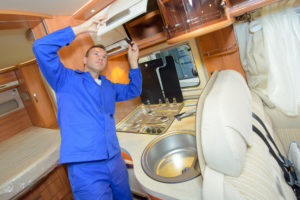RV Repairs Guide: 6 Parts You’ll Probably Have to Replace
Contents
Actively using your RV and its amenities on your many adventures means that eventually, parts are going to need to be replaced or serviced. It’s a normal part of owning an RV, and even with proper maintenance, things wear out over time. In order to help you be prepared for the inevitable breakages, part failures, and inconvenient malfunctions, here are some of the most commonly replaced RV parts, as well as some tips for how to make them last as long as possible.

1. Shower Seals and Door Sweeps
These RV accessories see a lot of regular use, particularly if you live the RV life year round. Every few years you are going to need to strip out and replace the seals and door sweeps on your shower. This cleaning and replacement helps prevent water from leaking out around the edges, allowing mold to form and permanently damage your RV’s floor.
Once you get everything stripped out and scrubbed clean with shower cleaner and bleach (the REAL mold killer), you need to reseal everything with silicone sealant and replace the door sweeps with a factory replacement or an OEM part. Alternatively, you can use a standard shower door sweep and cut it to fit with a retractable razor blade or similar cutting tool.
2. Holding Tanks and Component Parts
The holding tank of your RV holds three kinds of water: fresh drinking water, washing water, and blackwater. If you aren’t familiar with the euphemism “blackwater”, it’s the sewage tank that empties the toilet when you flush. Drinking water and washing water drain naturally into the wastewater compartment to be flushed out with the blackwater via a sewer connection. Most RV owners will experience some leaking around the seals at some point, and should the tank be punctured by a road hazard, you will need to patch it up with a tank repair kit or some sealing epoxy. Keep a tank repair kit handy for these occasions.
The chief area of concern for most RV owners is the blackwater tank. If you are maintaining your system appropriately every time you dump the blackwater tank, then you shouldn’t need to replace it or repair it often. Failing to flush out and rinse the pipes and tank after dumping means unpleasant aromas filling the cab and potential equipment failure. There’s no cleanup quite so unpleasant as raw blackwater, so make sure you keep your sewer system clean and flush regularly after dumping the tank. Repairs are expensive, and should your tank or pipes spring a leak, you will need to repair them before you can travel again and use your portable toilet in your RV. Epoxy pipe repair kits and thermal welding are both excellent leak solutions for blackwater tanks, but thermal welding requires specialized equipment and is much more labor intensive.
3. Plumbing
Insulating your pipes against dramatic changes in heat and cold is extremely important, especially if you live in an RV full time. Burst pipes can be expensive to repair, and cleaning up the damage in the cold can be extremely difficult. Wrap your pipes in thermal pipe insulation, and keep pipe repair kits handy in case your pipes do freeze or burst.
4. Weather Seals and Internal Structures
Over time, hot weather can destroy the rubber weather seals around your doors and windows, allowing air and water to leak in. Worse still, it has a tendency to loosen much of the adhesive that holds said seals and other components of your RV together. Always keep some repair epoxy handy, as well as a couple of tubes of silicone sealant. Even minor leaks can turn into major repairs if mold or mildew take hold in your RV’s structure.
5. Electric Generators
In order to keep your generator in good working order, it needs to run from time to time even when the RV is not in use. Keep the right oil/gas blend in your generator throughout the year, and be sure to run the tank dry or close to dry before putting your RV in storage for the off-season. Every 3 months or so, put a little oil and gas in your generator and fire it up. Make sure it runs until the fuel is completely consumed.
RV generators also use integrated carburetors, which means that you can only replace them, not repair or clean them. Firing up the generator regularly helps blow accumulated carbon from spent fuel exhaust out of the carburetor, which is the best you can do to keep it clean with an integrated unit.
6. Awnings
This is the most commonly repaired or replaced part on any RV. Rainwater can pool in improperly aligned awnings, and the weight can put severe straining on the arms. If the wind kicks up, your awning effectively becomes a sail, and the arms strain against the wind.
If you get some heavy gusting during a storm, it can break the awnings retractable arms or take them clean off. The best way to avoid these two common forms of awning damage is to tilt the awning down at an angle to help keep water from pooling, and if the wind starts picking up, retract your awning altogether to prevent it from being damaged.
Final Thoughts
No matter what needs replacing on your RV, you don’t want to have to deal with that problem out on the road unprepared. Keep your RV repair kit handy with epoxy sealant and repair kits, silicone sealant, and thermal tape for repairing seals and leaks. An ounce of prevention is always worth a pound of cure, and this is especially true when it comes to RVs.
Getting ready for a major RV journey? Need help making sure everything is in tip-top shape before you head out? Bring your RV to Kirkland RVs for a full service checkup before your next trip. Our expert technicians can help provide you with the peace of mind you need to make every trip in your RV memorable for all the right reasons. Call or visit our website today for details.

